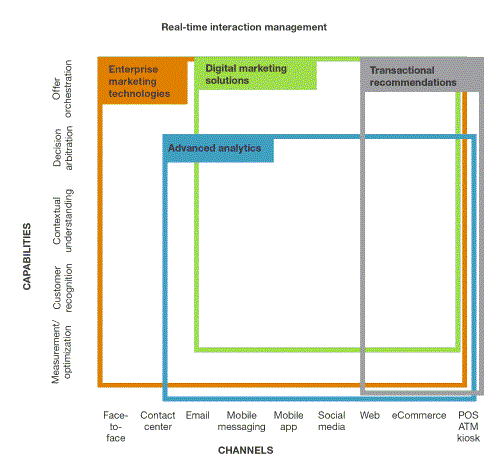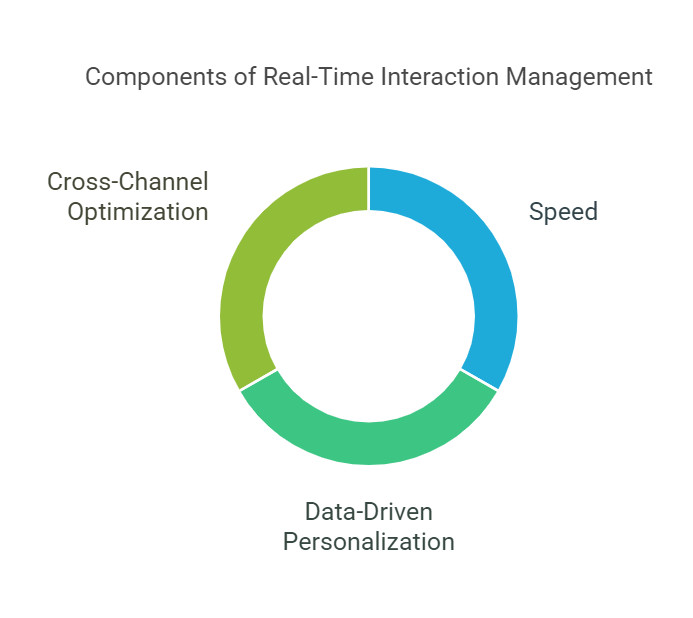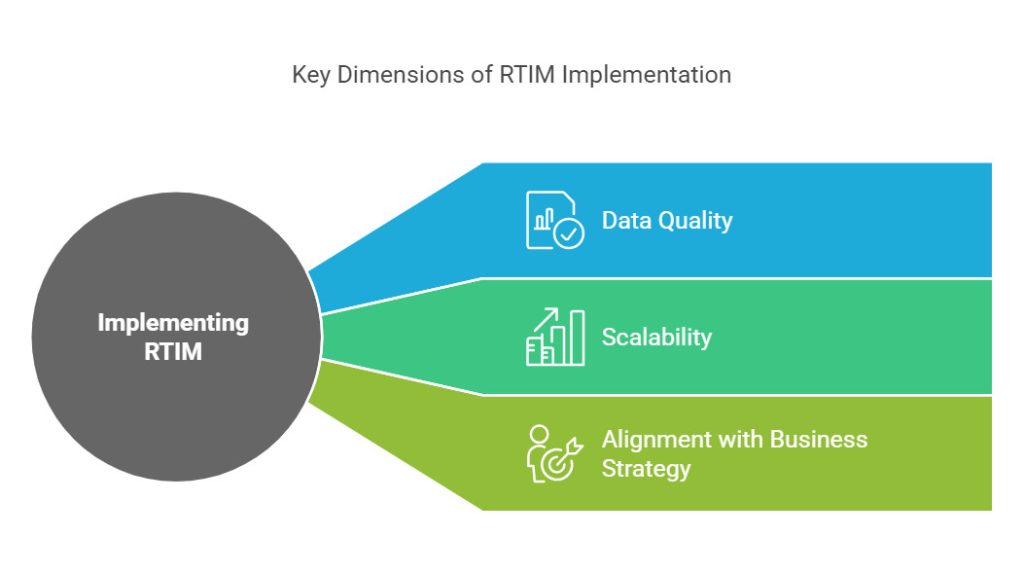- Research platform
Sources of information
Data analysis
Actions
- Solutions
For whom
Problems / Issues
- Materials
Materials
- About us
About us

In today’s digital world, businesses look for ways to boost customer engagement and improve interactions. Real time interaction management has become a key solution. As an enterprise marketing technology, it integrates various domains such as data, analytics, and customer experience to enhance customer engagement. It helps organizations respond quickly to customer behaviors and choices. This approach uses live data to customize experiences, leading to better customer satisfaction and loyalty.
What is real time interaction management? In this article, we explore core ideas of RTIM. We cover the main capabilities and highlight benefits it gives businesses. Also, you’ll see how AI is important in improving RTIM practices. Combining RTIM with customer journey orchestration can create better experiences for audience. Whether you’re new to RTIM or want to enhance strategies, this post gives insights to help in handling today’s consumers.
Real Time Interaction Management is a type of marketing tech that helps deliver experiences during the customer lifecycle. Its main aim is to improve customer engagement by offering personalized interactions based on individual needs and preferences.
Real Time Interaction Management uses data and analytics to meet this aim. Businesses analyze current customer behaviors and interactions to create communications tailored for specific needs of customer, which boost overall experience. RTIM enhances the customer's journey by delivering contextually relevant experiences at crucial points throughout their lifecycle. This ability to respond quickly is key in today’s fast-moving digital world with rising consumer expectations.
Moreover, Real Time Interaction Management connects various customer touchpoints. This ensures a seamless customer journey across different platforms. Such integration is important as it helps businesses build a unified profile of each customer. This lets marketers create more effective strategies based on better insights. Managing interactions in real time also aids personalization efforts and positively impacts lasting customer relationships and loyalty.
Lastly, Real Time Interaction Management is crucial in modern marketing practices. Using abundant data and advanced analytics enables businesses to change a normal customer journey into many personalized experiences to boost satisfaction and engagement.
As we explore more, we will look at how Real Time Interaction Management empowers businesses to meet their customer experience objectives effectively.
Real-Time Interaction Management (RTIM) is a sophisticated technology that hinges on several critical components to function effectively. These components work together to deliver personalized and contextually relevant experiences across the entire customer lifecycle.
By understanding and implementing these key components, businesses can harness the full potential of RTIM to enhance customer engagement, satisfaction, and loyalty.

Real Time Interaction Management offers strong framework for businesses. It help these modern companies connect with customers effectively. The unique abilities of this system allow firms to craft customer experiences that Boost both engagement and satisfaction.
One main advantage of Real Time Interaction Management is its speed. Fast delivery of relevant messages is key for customer interactions today. Customers now expect quick responses. RTIM matches these needs by processing information instantly and forward it without any lag.
Data-driven personalization stands out in Real Time Interaction Management. By deeply analyzing customer data, organization treat customers uniquely. This strategy avoids broad categories. Tailored interactions improve customer experience significantly. Companies that utilize data-driven methods see up to 30% boost in engagement, which shows the effect of this idea.
Cross-channel optimization makes a difference with Real Time Interaction Management. It help businesses use technology for better engagement strategies. This feature ensure that customers have consistent experience, whether they use emails or social media. Integrating messages reinforces the brand presence and builds customer loyalty. RTIM leverages preferred customer touchpoints to deliver relevant experiences at critical moments in the customer lifecycle.
With these capabilities of Real Time Interaction Management, businesses not only improve their strategies but also create stronger relationships with customers. Implementing the right tools in RTIM allows organization to meet and exceed customer needs, setting ground for discussing the benefits and business value of this system.
Real Time Interaction Management provides benefits that impact business value. It enhances customer engagement and increases efficiency in marketing. Personalized customer experiences drive better engagement and loyalty by responding to individual customer needs through data-driven insights. A major advantage includes the Single Customer View. This view merges real-time interactions with past data, crafting a comprehensive profile of each customer.
With better profiles, Real Time Interaction Management boosts marketing performance. Timely decisions let businesses deliver personal offers at the right moment. This responsiveness increases engagement. It also leads to higher sales outcomes.
RTIM ensures a consistent experience across channels. Businesses provide seamless interactions whether online, in-store, or through apps. This consistency improves satisfaction and builds loyalty. Customers receive equal service regardless of their interaction choice.
Implementing Real Time Interaction Management can boost customer retention rates. Companies can engage customers promptly. They can address concerns and provide support. Tailored solutions foster loyalty for many users.
Companies using RTIM see a notable boost in marketing return on investment. Aligning interactions with marketing efforts optimizes resources. It leads to more focused strategies and better campaign success. The result is targeted marketing that speaks to preferences.
In conclusion, the advantages and business value of Real Time Interaction Management are many. By using RTIM, companies create a personalized customer experience. It strengthens marketing, ensures channel consistency, and enhances overall satisfaction. As businesses grow, they must think of how to integrate RTIM to gain maximum rewards.

Implementing and integrating real time interaction management requires planning and consideration of various critical factors. Organizations want to use real time interaction management for better customer engagement and streamlined operations. First, they need to assess their current infrastructure and data quality.
One key step in real time interaction management implementation is checking data quality. Organizations mustbe sure their customer data is accurate, complete, and current. Inaccurate data can cause misguided interactions, which reduces the effectiveness of instant insights. This involves evaluting how customer information is gathered, stored, and processed. Companies should establish methods to cleanse and enrich their data regularly.
Scalability is a vital factor in real time interaction management. As customer interactions rise and the amount of data grows, the chosen technologies must scale properly. Organizations need to find platforms that offer strong scalability to fit changing customer data demands. This adaptability helps maintain a competitive edge and ensures that real time interaction management systems can grow with the business.
Additionally, aligning real time interaction management with overall business strategies is crucial. Real time interaction management should address immediate engagement needs and back long-term organizational goals. Ensuring this alignment makes all customer interactions coherent. It also contributes to the company's broader vision. When real time interaction management strategies integrate into the business model, they can generate more value while improving customer experience and operations.
By strategically implementing and integrating real time interaction management, organizations can respond efficiently to customer needs. This paves the way for stronger relationships and higher satisfaction. Successful integration requires focus on data quality, scalability, and alignment with business objectives.
As businesses optimize their real time interaction management systems, the role of artificial intelligence grows increasingly important. The next section will discuss how AI technologies enhance real time interaction management capabilities, allowing for more personalized and effective customer interactions.
Artificial intelligence has a key role in improving real time interaction management. It uses features that allow systems to respond smartly to customer actions. Predictive analytics are core of AI. It enables businesses to predict customer behavior and preferences. This assists organizations in customizing real-time responses, allowing for personalized and relevant interactions.
Adaptive AI tech is also important in real time interaction management. It lets systems modify strategies based on current data. By always watching user actions and changes in the environment, these technologies create feedback loops. Past customer interactions shape the decisions made later. More data leads to better engagement strategies, allowing for targeted communications.
Moreover, adaptive learning in AI makes sure systems don't stay the same. They grow and improve continually. This is important for keeping customers satisfied, as it helps the interactions match their evolving preferences and expectations. Companies can use insights from earlier engagements to make customer journeys smooth and intuitive.
In summary, AI improves real time interaction management with predictive analytics and adaptive learning. Organizations build stronger connections with customers. The combination of these AI abilities means businesses can react to immediate situations and also create future interactions that align with customer likes.
As we look deeper, it becomes clear that joining real time interaction management with customer journey orchestration can enhance these advantages. It leads to a full approach that encourages ongoing engagement and loyalty.
Evaluating the success of Real-Time Interaction Management (RTIM) involves a comprehensive approach that considers various metrics related to customer experience, engagement, and business outcomes. Here are some key metrics to track:
By tracking these metrics, businesses can gain valuable insights into the effectiveness of their RTIM strategy. This data-driven approach allows for continuous optimization of customer experiences, leading to improved business outcomes and sustained growth.
Real time interaction management and customer journey orchestration are important strategies. When used together, they can improve customer engagement and business success. Real time interaction management delivers immediate responses based on data and behavior. Customer journey orchestration looks at the whole customer lifecycle and multiple touchpoints. This combination creates a chance for businesses to utilize both methods for a seamless customer experience.
Integrating real time interaction management with customer journey orchestration allows businesses to customize communications. They can address the specific needs customers have at each journey stage. This combination helps brands react to immediate inquiries while predicting future needs. For instance, if a customer often browses a product section, real time interaction management can activate relevant promotions. Meanwhile, the customer journey strategy guarantees consistent messaging through emails, social media, and stores.
Additionally, establishing a united approach that connects these strategies results in smooth experiences across channels. Today's customers look for personalized services; in fact, 73% of shoppers prefer to engage with brands delivering personalized experiences. By combining real time interaction management with journey orchestration, companies can satisfy this demand. They provide a tailored experience that meets immediate interactions and aligns with long term expectations.
To summarize, the link between real time interaction management and customer journey orchestration boosts customer interaction effectiveness. This happens through relevant and context-aware engagements. As a result, businesses see greater customer satisfaction, loyalty, and ultimately increased conversion rates, which leads brands toward a customer-centric growth path.
In summary, real time interaction management is vital in the current digital space. It helps businesses to connect with customers by using data quickly. This article explored the abilities of real time interaction management, like tailored communication and active engagement. It discussed key advantages, including better satisfaction.
When you think about using real time interaction management in your business, be sure to take steps forward. You can start by finding important data that will enhance your conversations. Each step helps build your ability to manage interactions. Aim to create strong links with customers that can bring value.
Finally, adopting real time interaction management will nurture your relations with clients. It also prepares your brand for growth in a tough market. Begin now to harness the benefits of real time interaction management for better customer relations!
Copyright © 2023. YourCX. All rights reserved — Design by Proformat